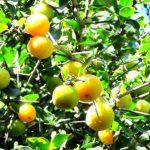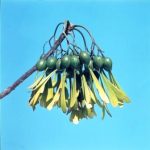TREE LIFE
SEPTEMBER 1990
MASHONALAND CALENDAR
Tuesday 4th September : Botanic Garden Walk. Park your car at the Herbarium where we will meet Tom Muller at 1645 hours to 1700 hours.
Sunday 16th September : To Les and Carol Harvey’s farm – Malabar in the Darwendale Area for an unusual outing. After treeing along the Munyami river in the morning, we will have our lunch on the lawns of Les and Carol’s fabulous garden which was featured in the S.A. Garden and Home a few years ago. Les and Carol grow flower seeds for export and to see fields of vivid colours instead of the usual crops will be a treat
Saturday 22nd September : Walk with Mark in the Mukuvisi Woodland. Meet at the main car park by the office at 1500 hours. The exact site in the woodland to be determined.
MATABELELAND CALENDAR
On Sunday September 2nd we will go to Gordon Park (the Scout Camp) in the Matopos. Meet at Retreat at 0830 hours. Bring lunch and chairs.
MATABELELAND NOTES
On Sunday August 5th we went to the Esigodini area, to Ponderosa Farm, the home of Colin and Judy Martin, where we had a very good day. In the morning, after tea, we went to the lower area of the farm along the narrow twisting Lunga River, now dry, apparently. In this very grassy area, we only identified some 20 species but they were of some interest. Along the stream were large numbers of River Combretum, C. erythrophyllum, some of a very good size, then a little further away some heavy grass cover interspersed with patches of small Acacia, mainly A. karroo. Here and there, nearer the river, were some quite fertile ant heaps, usually crowned with a large Ziziphus mucronata and a nice collection of plants in its shade, several of them with extra large leaves, coppice growth perhaps? Bridelia mollis, Euclea divinorum, Turraea nilotica especially.
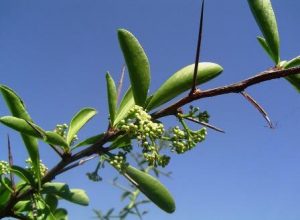
Maytenus heterophylla subsp. puberula. Photo: Bart Wursten. Source: Flora of Zimbabwe
There were two other Euclea species, E. natalensis and a good number of E. undata, also Carissa edulis with an occasional Y thorn, Maytenus heterophylla and M. senegalensis and many large green Rhus lancea, a bit short leaved. The river was not a sandy one.
After lunch we went to the upper part of the farm, with many small kopjes, in a sea of grass. Here we added another 50 species, plus half a dozen queries. At the homestead, there was a magnificent lead wood, Combretum imberbe, but regrettably its flower buds were falling and some of the many branches were dying, so maybe its end is near. Later we encountered another good sized lead wood being completely strangled by a Ficus thonningii. Among the species in the upper area were – Acacia ataxacantha, A. galpinii, A. gerrardii, A. nilotica, A. rehmanniana, Albizia amara, Azanza garckeana, Bolusanthus speciosus, Burkea africana, Carissa bispinosa with full Y thorns more prominent here, Cassine matabelica, Combretum apiculatum, C. hereroense, C. molle, Croton gratissimus, mainly in the rocks though one was well away from them, Dovyalis caffra bristling with large thorns, F. ingens, F. glumosa, F. natalensis, f. thonningii, Flacourtia indica, most in very red leaf, Grewia flavescens, G. monticola, Lannea discolour many Lonchocarpus capassa, some with a bare bole and leafy crown, Maytenus heterophylla subsp. puberula, Mimusops zeyheri, Ozoroa insignis subsp. reticulata, Schrebera alata, Securidaca longepedunculata, Strychnos spinosa, Tarchonanthus camphoratus, Vangueria infausta and Ximenia caffra, in all over 70 species, with a little leaf, quite notable.
-C.Sykes
Editor’s note : the queries to which Charles Sykes refers have since been identified as Maerua angolensis, Diospyros mespiliformis, Boscia angustifolia, Grewia flavescens, Hibiscus mutabilis
BALKIZA FARM – AUGUST 1990
There was a strong hint of spring in the air as we made our way to Balkiza Farm, which lies (as the crow flies) about half way between Harare and Mazowe Citrus Estates. The approach, between kopjes ablaze with the new leaves of Msasa trees, Brachystegia spiciformis, was a welcome introduction to a very interesting day, with 97 ticks on our field card at the end of it.
Accompanied by a flock of curious ostriches (one of which, No. 50, was a little too friendly at times), we made our way along the bank of the dam which was dotted with small granite outcrops, thus widening the variety of trees. Pappea capensis had just finished fruiting and so we had to accept that the astringent fleshy fruit was pleasant to eat. Fortunately we found another by the dam wall, the fruit not yet quite ripe but leaving a very pleasant after taste none the less. Osyris lanceolata with tough green leaves and the petiole running down the stem to form ridges there was unsually large in some cases. Bridelia cathartica subsp. melanthesoides was fruiting well but would require a week or two before the fruit ripens and falls to leave the bracts and sepals which give the branchlets the distinctive knobbly appearance.
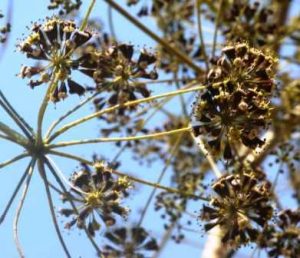
Steganotaenia araliacea. Photo:Bart Wursten. Source: Flora of Zimbabwe
Turraea nilotica was just coming into flower as was Steganotaenia araliacea and Euphorbia matabelensis. None of these three had a leaf in sight, other than the remains of last season’s. Rhus longipes and R. tenuinervis were making a tenuous attempt to flower as well.
We noted both Monotes engleri and M. glaber, the former having leaves distinctly paler on the underside than is the case with the latter. Both, of course, have the extra floral nectary at the base of the midrib, perhaps to entice insects to the leaf axils from which the flowers grow?
Once again the wonders of the bush unfolded before us and our grateful thanks go to Pat and Trance Braggs for their hospitality.
-E.R.R.H.
NYARUPINDA CATCHMENT
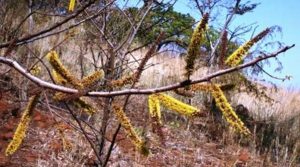
Elephantorrhiza goetzei. Photo: Mark Hyde. Source: Flora of Zimbabwe
Tinto homestead is delightful with the sight of Namaqualand daisies and the sound of Namaqua doves. Spring has come to the catchment. Msasa trees became conspicuous in July when their crimson new foliage was suddenly there, trembling in the breeze. This event spurred us on to seek the signs of the changing seasons in the woodland along the stony ridge where the Mimosoid legume, Elephantorrhiza goetzei grows; their maroon flower buds had set free clusters of bright yellow stamens, making the visage of this small tree a colourful spikey zigzag of leafless twigs.
Fig flowers/fruits come ‘bustin out all over’ in July, Ficus ingens, F. stuhlmannii, F. thonningii but F. sur has middle aged fruits at the moment. The tree we saw from afar was Ficus sycomorus. St. Matthew and St. Mark recorded that Christ put a curse on a fig tree, saying “let no fruit grown on thee henceforward forever” and “No man eat fruit of thee hereafter, forever”. This raises the question, is there a fruitless Ficus? A species which only vegetates.
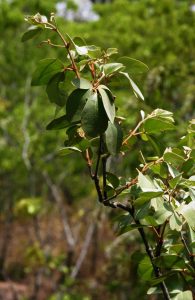
Rhoicissus revoilii. Photo: Bart Wursten. Source: Flora of Zimbabwe
The ridge begins with a kopje adorned with many Kirkia acuminata, the canopy of it bore dry capsules shedding winged seeds. Next to these were several Pod Mahoganies where Turtle Doves perched amongst the woody pods. Tall leaf scarred stems of Carrot Tree are decorated with a brown filigree of three or four tiers of umbels, a fairy story picture, dainty and beautiful but shivering in the cold wind of August 13th. Proteas stand up to this kind of weather, amongst their dead flower heads there are infructescence which deserve a second look because some still contain hard brown furry fruits. These are a shed gradually, the camouflage and strategy is part of their survival plan.
The ridge ends with a kopje at the lowest point near the Nyarupinda dam, this is an eerie place, frequented by snakes. It took a bit of courage to go treeing and leave my companion with the horses. Luckily there was a cheerful sight on this scary walk around the base of the kopje, Pittosporum viridiflorum was glossy in the sunlight and its dehiscing capsules showed resinous red seeds which looked like ‘Kermit’ frog faces, they smiled. Up aloft near the beacon were more Elephantorrhiza surrounded by Rhoicissus revoilii, together a pleasing colour combination. Almost missing a huge lanky succulent plant was the highlight of this recce. This reminded me of those succulents at Reps Theatre, so large at close quarters, that they escape recognition. Elephants and lorries also have this quality. Were these tall plants members of the Spurge family? Had the writer been Under Milk Wood beside the rocks and at Reps. At Dylan Thomas’ poetic play? Appeal has been made to members of the ‘succulent’ society for the name of the trees which hug the wall of the theatre near the path to the members car park. Their reply may confirm that this flight of fancy is not entirely frivolous.
On termite mounds Dombeya rotundifolia is flowering before dropping its leaves yet others are behaving normally, below these, Maerua juncea’s green whippy stems bear flower buds soon to open into a sunburst of stamens. One Lannea discolor was ahead of all the others, in full bloom beside a cattle grid, its precocity may have been due to FYM (farmyard manure).
On 19th July at lunchtime a Lappet faced Vulture was sighted from the garden, it was flying fairly low downstream over the Nyarupinda Dam. Its colouring was so distinct and its deep heavy body was diagnostic.
Parinari curatellifolia is in flower now, it is uncommon in this catchment because most of the soils are well drained. A wood sample of this tree has evaded us for at least ten years, but dry wood at ground level has now been found, from which a piece can be taken without fear of offending the Mashona people who regard this tree as the home of the Great Ancestral Spirit and their prayers were answered under the Muhacha tree. Also in flower now are Rhus longipes, stem fruit and woodland waterberry.
Securinega virosa, now Flueggea virosa. When a filly at Tinto began her formal training a search was made for a suitable stick to make a lunging whip. Securinega was chosen because it was straight enough, long, tough, light and flexible, to this the lash was attached. Just a light flick at the heels and she got the message, but often she is lazy. A member of staff at a safari camp in the Luangwa valley never needed a box of matches because he was expert at making fire by friction; he drilled the hard wood of Securinega against a piece of Trichilia emetica, this was the routine for making tea, anytime, any place.
A shade tree – to be or not to be? A Brazilian Rosewood, Tipuana tipu, planted as a shade tree on the lawn at Tinto is architecturally disappointing. It is tall and straight, the view is not hidden by the branches, but the branches do not radiate evenly around the trunk. Knife incisions which promote or inhibit the growth of selected buds have been made in an endeavour to correct this fault.
Before these cuts are made it is important to examine the trunk or stem of the young tree, in order to select and mark those buds which are pointing in the correct direction for the branches so that there is no overcrowding. The dormant season is the best time for this procedure.
To promote the growth of a bud a small wedge shaped piece of bark (rind) is removed in the tangential plant, starting about 1cm above a dormant bud. This has the effect of keeping the rising sap in the vicinity of the bud. To inhibit development of a bud a nick (similar to that in an old fashioned cotton reel) is angled upwards into the bark, starting the incision not less than 1cm below a dormant bud. This interrupts the flow of sap to the bud. At the moment the Tipuana is quiescent; a small amount of sap has oozed from the incisions, dried and healed the injured tissues.
It remains to be seen if this technique is successful. Usually Brazilian Rosewood trees are very fast growing and require ‘heading back’ of long lax branches annually whilst the tree is young. The disadvantage of this species is that its roots are as rampant as its canopy. In this situation where it grows in ameliorated quartz rubble, it is hoped that it will be a satisfactory shade tree.
This explanation has been rather heavy going, the writer trusts that it has been worthwhile and of interest to some of the readers.
Is this a record? An Acacia nilotica pod with 16 seeds. This is an impressive pod, but no doubt several of the seeds have been parasitized.
-Benedicta Graves
TREES OF THE BIBLE (continued)
THE ECONOMIC SECTION : After you pass the yellow trunks of the fever trees continue straight on the strip of lawn until you reach a row of paving stones. To the right you will notice palms on both sides of the paving stones. Amongst these trees are two species of palms, the oil palm (Elais) which has roof like leaflets, and the date palm (Phoenix dactylifera) which has gutter like leaflets. These date palms are growing slowly but in hotter climates they grow much faster, forming tall graceful trees that are most productive. Solomon compared the Shulammite maiden to a palm and her breasts to date clusters (Songs of Solomon 7:7-8). The Hebrew word for palm is Tamar and daughters were named after these trees. You may recall the story of Tamar who was married off to Er and then to Onah, both were put to death for sinning, she then seduced her father in law, Judah, this resulted in a complicated but interesting delivery of twins, one of whom, Perez, continued the Messianic line (Genesis 38 6-30). The word Tamar also reminds us of another important fruit tree, the tamarind, or date of India. Tamarind trees, Tamarindus indica, are common along the Zambezi River although no one is quite sure whether they are indigenous or whether they were introduced by foreign traders many centuries ago.
THE CAROB TREE
Walk back along the paving stones until you can see all the way to the lake past the fever trees. Turn right and notice that the narrow strip of lawn from the lake leads directly to three trees with dark green leaves. The first two are macadamia trees that have simple leaves with sharply serrated edges. The third tree, slightly to the right, is the carob tree, Ceratonia siliqua, which grows throughout the Mediterranean region. The leaves are compound and you may see flowers on the stem and branches, but this specimen does not set fruit. Carob pods have a juicy pulp that contains sugar and gum, they are often fed to horses, cattle and pigs. In one of the parables Jesus described the prodigal son a being so hungry he contemplated eating the carob pods that he fed to the pigs (Luke 15:16). The carob is often called locust bread or St John’s bread because it was thought than John had eaten carobs and not real locusts in the Wilderness of Judea (Matthew 3:4). The importance of the carob was highlighted in Spain and Portugal when it was discovered that children were more likely to die of infantile diarrhoea in wealthy homes than in poor homes. This was linked to the fact that poor parents supplemented their children’s diet with carob pods. Carob seeds are said to have been the original weight which has led to the jewellers carat (200mg).
ACACIA TREES
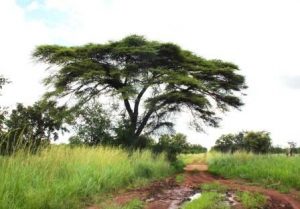
Acacia tortilis. Photo: Bart Wursten. Source: Flora of Zimbabwe
Starting with the lake off to our left and the carob tree on your right wander along past a young baobab tree on your left, pass the sign LOWVELD TREE SAVANNA –SABI LIMPOPO SECTION on your right. Way off to the right you will just see the sign announcing the ACACIA SECTION. Immediately to the left of the sign are two species of Acacia, the one to the left is a sprawling species with a yellow trunk, it has straight thorns and balls of yellow flowers. This is Acacia seyal which is not indigenous to Zimbabwe. To the right of the sign there is a taller tree which, if you look very carefully, has two types of thorn, some that are long and straight and others that are sharply hooked. This is Acacia tortilis which is a common flat topped tree in the lowveld of Zimbabwe. Both of these species grow in the Negeb and the Sinnai area where the Israelites wandered in the wilderness for forty years after having fled from Egypt. It was while they were in the wilderness that they built the portable tabernacle so it seems appropriate that they used Acacia wood. Acacia trees provided timber for the ark of the covenant, the table of show bread, and altars as well as the poles that carried these items around. Most of these items were overlain with gold (Exodus 25:10-16; 23:28; 26 : 15, 26, 32, 37; 27: 1-6; 30:5; 36:30, 31 36; 37:1,4,10,15, 25, 28; 38:6).
THE OLIVE TREE
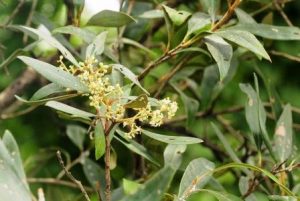
Olea europaea. Photo: Bart Wursten. Source: Flora of Zimbabwe
Behind these trees there is a tarred road that runs through the gardens. Find this road, turn left and stroll around a number of bends, pass a turn off to the left and one to the right, and find a sign indicating HIGHVELD RIVERINE WOODLAND and behind the sign is a clump of thick bush. Make your way around to the left of these bushes, until you find a relatively tall multi trunked tree. There are at least two other similar trees nearby. These olive trees belong to the same species as the commercial olive Olea europaea although they are a different variety (var. africana). Look at a branchlet and notice the simple leaves that are opposite on the branch. Noah knew that the flood waters had subsided when a dove brought back to the ark an olive leaf just like these leaves – Genesis 8:11. artistic licence has changed the leaf into a branchlet and this is now a symbol of peace. The olive tree also represents beauty and dignity.
The fruit on wild olives is small – 10mm. In biblical times shoots of commercial olive trees were grafted onto wild olives to make them productive. This has been tried in Zimbabwe but the crop is poor and suffers from shot-fruit. Another problem is that the temperatures need to drop below 13 degrees C in order for the flowers to set fruit. It is peculiar to think of grafting wild olive shoots onto a commercial olive tree, yet this was the comparison that Apostle Paul used to describe how the Gentile Christians had been grafted on after the Jews had rejected Jesus as the Messiah
Wild olive trees are common in the Mazowe Valley, the Matopos and in the rain forest at Victoria Falls. They also grow all around the Mediterranean, but here the commercial variety is widely cultivated. These trees may grow rapidly but they take ten or more years to produce fruit. This is why the promise of a land that already had oil, olives and honey, with vineyards and olive trees that they had not planted was most appealing (Deuteronomy 6:11; 8:8; Joshua 24:13). Ripe olives are still harvested by beating the tree, just like they did in biblical times (Deuteronomy 24:20’ Isaiah 24:13).
It has been suggested that the Israelites only used olives as a source of oil and did not eat the fruit the way that we do. This is because the fruits contain a bitter compound that is water soluble. When the fruits are pressed this compound is washed away and the oil that separates out is untainted. At some point in history it was discovered that fruits were edible if soaked repeatedly in water and pickled in brine for some months. A good tree can yield 40 – 60 litres of olive oil, this represents a year’s supply for a family of five or six. Olives are usually pressed in stone presses called gath shemaneh in Aramaic, this was the origin of the name Gethsemane, the garden to which Jesus retired after his last supper (Matthew 26:36). It is appropriate that this press was on or near the Mount of Olives, although many of the olive trees on these hills were cut down during the Roman siege of Jerusalem in 70 AD. Micah 6:15) refers to treading olives but I am not sure I would enjoy leaping on olive stones.
-Kim Damstra
MUKUVISI WOODLAND NOTES
Syzygium is an important genus, well represented in the woodland not numerically, but in ecological importance S. guineense subsp. guineense marches across the Chiraura Vlei, following the course of under ground streams. More or less trotting along side is subsp. huillense. Taxonomists, I think, may have doubts about the status of this latter as a true sub species. Secretly, so do I. There is one individual I watched for ten years, and it looked a happy huillense. Then in November 1987 something happened, it began to grow again and it turned into a guineense.
S. cordatum is more frequent with a mature colony on the lower Chiraura and a younger colony along the Makabusi upstream from the reed beds. This latter has developed exceedingly well since 1980, mind you we had to put in some real hard work to achieve what we now see as a lovely example of regeneration, hopefully towards return of full gallery forest status.
Near the car park we have established an artificial colony now fruiting every year. I find S. cordatum a fascinating plant, where it grows one finds good soil/water conservation. Extirpate your cordatum and you are liable to lose your top soil. An over simplification I agree, but look around you and you will see it does happen.
It is said that when the nguni invaders, early nineteenth century killed the last mambo in Matabeleland, he died cursing perpetual drought on the country his people had thus lost. I believe he had lived alongside the invading tribe to observe, that they had no respect for the waterberry groves at key points in catchment areas and chopped them out. By the instinctive wisdom inherited from his forebears the dying man knew that such bad conservation would destroy the water holding capacity of the land.
After years of observation and limited experimentation I have learnt little of the precise place of this tree in succession, and even less about its finite soil preference. One sees it as both canopy tree and a forest edge pioneer. Always it seems to need surface water. Fire is a limiting factor, but frost seems even more important in localising range extension. Sometimes it does in fact show much resilience to both fire and frost.
Certainly it is a versatile tree. I have seen one little plant, fruiting quite happily at 40cm in height, a natural bonsai in a soil filled granite pothole. It attracts birds to your garden, sunbirds, apalis, even the purple crested Lourie calls in to my quarter acre when it is in season.
Talking of frost and its effect. When we went to Chipoli in June we looked at a large Ekebergia capensis which may still be carrying scars of the big frost of 1968.
I have never read anything in print about this frost. The following evening the meteorological department provided some interesting details. I was in Bulawayo, as the sun went down I ‘smelt’ frost coming, the way one does in northern Europe. The following day, as I watched my pawpaws (Carica papaya) buckle and sag to the ground I realized that we had witnessed a unique phenomena, I could not help but think of the story of those super cooled air streams said to have frozen the elephants in Siberia.
We saw Acacia karroo and Acrocarpus fraxinifolius (Kenya coffee shade trees), up to ten metres high killed stone dead.
Bulawayo saw burst water pipes from freezing water, most of all I was sad for the sunbirds who lost all flowering material for days after the big freeze.
I am sure there are among our readers some who retain anecdotes and information about this big frost, its effect on vegetation etc. I would be happy to hear from you. I would be equally happy to told of anything in the literature.
-George Hall
TREE MAPPING
If anyone in the Harare area has a little time to spare and would like to help transferring information to our Q.D.S. maps please phone Fiona Dawe on 45404. Fiona has set up a system and would welcome some help.
BLOSSOM TIME (continued)
Orange to brown or red-brown flowers
Orange colours are often due to the presence of carotenoid (orange or yellow) pigments in the cells of the petals. The darker brownish and maroon colours may be the result of several pigments such as the carotenoids, anthocyanins and chlorophyll occurring in the same cell or in different cell layers lying on top of each other.
Flowers in this colour group are visited by a large variety of insects including bees and wasps. Moths may pollinate some of the tubular brownish flowers, and flies are attracted to the carrion smell of the brownish red members of the ASCLEPIADACEAE family. Birds’ sensitivity to red flowers is not exclusive and some of the tubular and nectar rich orange flowers are very popular with sunbirds. To insects orange may appear red to purple. Brownish colours are not particularly attractive to them and many such flowers appear to rely on scent to attract pollinators, especially moths at night.
Green or greenish flowers
Green floral colours are usually produced by chlorophyll, the pigment also responsible for the green colouring of leaves. Insoluble in water, chlorophyll occurs with other substances in roundish green bodies called chloroplasts which are distributed throughout the green parts of the plant. Photosynthesis takes place in the chloroplasts, and in this process the chlorophyll is of paramount importance in trapping a portion of the light energy radiated from the sun.
Pollinators that visit green flowers include flies (Ziziphus sp.), bees and moths. Although some pure green flowers are not easily seen by insects and depend on odour to attract pollinators, others may be scentless and rendered conspicuous by the presence of pigments reflecting ultraviolet rays. In the absence of ultraviolet effects, green flowers are probably perceived by insects as dull yellow-grey, thus blending with the similarly coloured background of the foliage.
P.S. Further information has come to light re Maerua juncea : Juncea means rush like not reed lick. The pliant whip like stems could have a use for binding as to rushes. ‘Info’ from Benthram and Hooker, British Flora.
The genus CALPURNIA looks very much like a yellow flowered form of VIRGILIA, and indeed, was classified as such for sometime. However, E. Meyer separated it, naming the new genus after Titus Calpurnias Sicilus who, in the early part of Nero’s reign, wrote poetry in direct imitation of Virgil. The generic name CALPURNIA is a whimsical reference to Virgil’s imitator.
DICK HICKS CHAIRMAN


